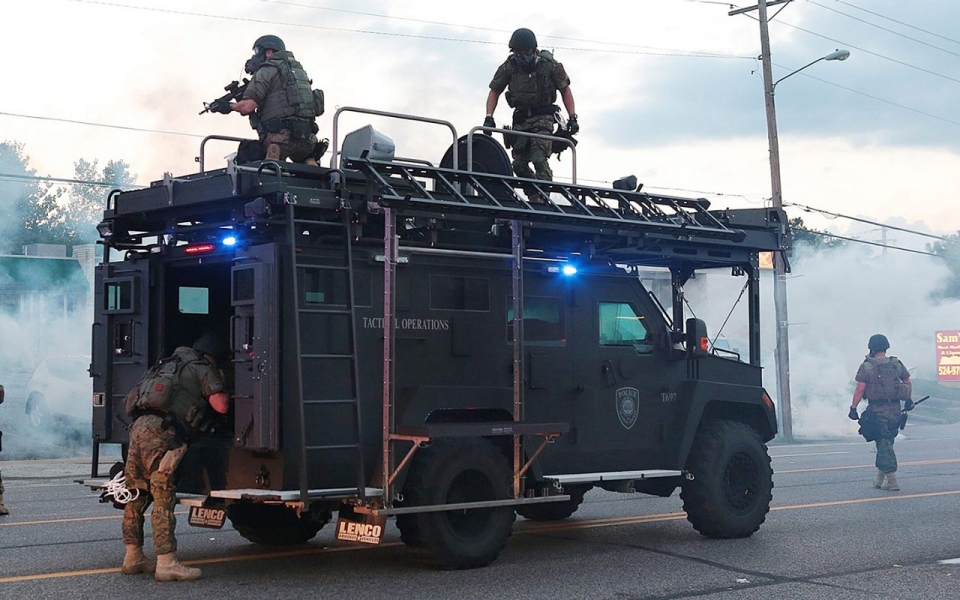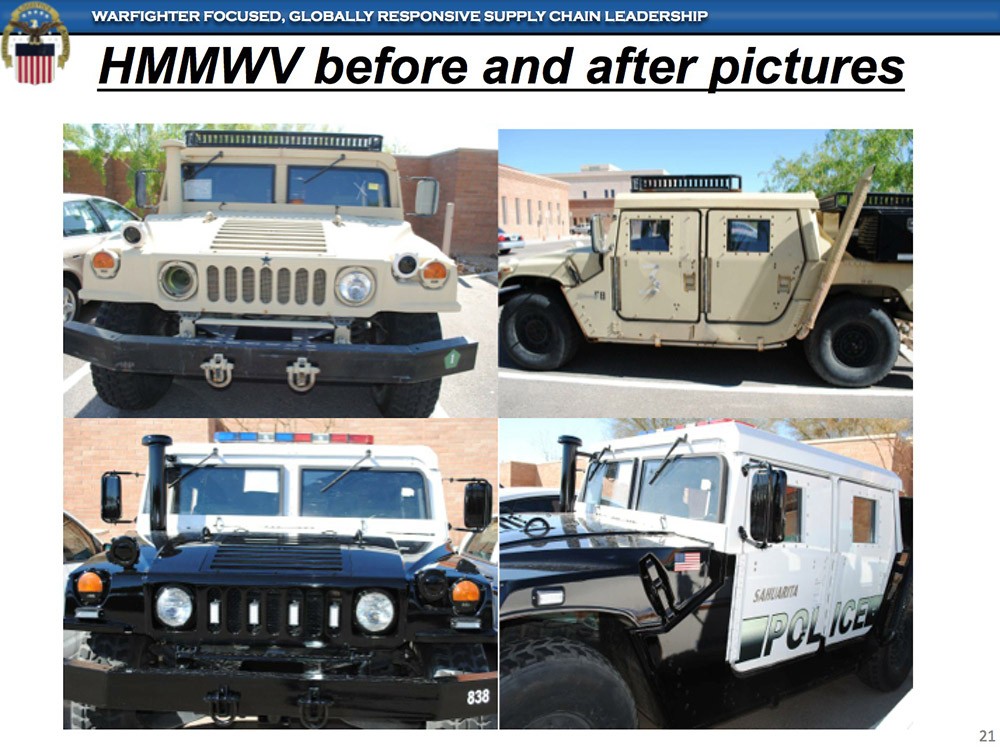
But as the world knows, this is Ferguson, Missouri, in 2014.
Even as the community struggles to come to grips with the tragic shooting death of yet another unarmed young African-American man, the events unfolding in Ferguson have thrown a spotlight on a second alarming trend: the increasing militarization of local police departments.
In response to protesters expressing outrage over the killing of 18-year-old Mike Brown, the St. Louis County and Ferguson police departments have turned the streets of this majority-African-American suburb into a veritable war zone, firing rubber bullets, menacing demonstrators with dogs and in general displaying excessive force for the purposes of security and crowd control.
"This militarization that we are witnessing - police officers dressed as soldiers, using military vehicles and military weapons to engage largely unarmed protesters - is outrageous," said Tom Nolan, chairman of the department of criminal justice at the State University of New York at Plattsburgh, who served for 27 years in the Boston Police Department. "It's a disgrace."
But as jarring as the images coming from Ferguson are, experts say the tinderbox situation on the ground was also inevitable, given how the federal government has readily handed over military-grade weapons, armor and equipment to local law enforcement with scant oversight or training.
It began with the war on drugs. Facing a deteriorating situation at home, Congress passed the National Defense Authorization Act in 1990, which allowed the Pentagon to give local law enforcement any surplus "personal property ... including smalls arms and ammunition." Twenty-five years later, the 1033 program, as it's called, continues and has disbursed $4.3 billion worth of military equipment to state and local agencies, according to the website of the Defense Logistics Agency (DLA), which administers the program within the Department of Defense.
Consequently, police forces across the United States are starting to resemble small armies, said Kara Dansky, senior counsel at the ACLU and the primary author of a militarization report, "War Comes Homes: The Excessive Militarization of American Policing."
"There are almost no constraints on the ability of local law enforcement to obtain military weaponry from the Defense Department," she said.
An slideshow on the 1033 program available at the DLA website shows what kind of equipment is available to police departments - Humvees, aircraft, armored personnel carriers, mine-resistant ambush protected vehicles (for surviving roadside bombs) and M-14 and M-16 rifles.
Mike O'Connell, spokesman for the Missouri Department of Public Safety, confirmed that the St. Louis County and the Ferguson police departments participate in the program. According to inventories, the Ferguson police have procured 12 rifles and six pistols as well as more mundane items like first aid kids and laptops through the program. St. Louis County has acquired eight utility trucks (which could include Humvees), night vision devices and cargo trailers.
However, O'Connell noted that some of the equipment seen in images of the protests has been acquired commercially and that the police presence includes officers from other units in the region.
Exacerbating police militarization, the Department of Homeland Security doles out multimillion-dollar grants to state and local agencies to pursue counterterrorism efforts, which often include acquiring sophisticated weaponry.
Equipping police officers with the trappings of war inevitably influences the psyche of law enforcement officials, experts said.
"When the police adopt this militaristic trope, they adopt with it this warrior mentality," Nolan said. "They think, 'Well, if we're fighting a war, we have to have an enemy.' And in this case, those are going to be unarmed, peaceful protesters. They are being treated as enemy combatants."
For now, Nolan added, cooling down the situation is crucial.
"I am someone who had rocks and bottles thrown at me in situations very much like this, and I didn't break out a sound cannon or tear gas or flash bang grenades or smoke bombs. I ducked," he said. "Let's put away the toys, boys. Get rid of the armored personnel carriers. Let's get rid of the military garb, the gun turrets, the machine guns, and let's begin a dialogue."
Victor Kappeler, an associate dean at the Center for Justice Studies at Eastern Kentucky University, said the problem extends beyond the Ferguson and St. Louis County police departments to the culture of violence within law enforcement.
"Policing has been a hypermasculine, conservative profession. And to a large extent, police culturally embrace violence as a form of problem solving," he said. "And when you equip them in [such] a way and you have a lack of leadership in the police agencies, this is the kind of behavior you're going to see as a result. A lot of these guys live for these kinds of situations - the opportunity to use force and to work a riot."
The silver lining may be that the unrest is Ferguson appears to have caught the attention of policymakers about the growing problem.
"At a time when we must seek to rebuild trust between law enforcement and the local community, I am deeply concerned that the deployment of military equipment and vehicles sends a conflicting message," Attorney General Eric Holder said in a statement on Thursday afternoon.
Holder added that local law enforcement agencies had agreed to accept federal help in managing the situation.
Sen. Rand Paul, R-Ky., who has spoken out on the need for criminal justice reform, added his voice to the chorus, writing in an opinion piece on Time.com that the federal government has encouraged a kind of arms race among police departments and that minority communities bear the brunt of overzealous practices.
"Washington has incentivized the militarization of local police precincts by using federal dollars to help municipal governments build what are essentially small armies - where police departments compete to acquire military gear that goes far beyond what most of Americans think of as law enforcement," he wrote. "When you couple this militarization of law enforcement with an erosion of civil liberties and due process that allows the police to become judge and jury - national security letters, no-knock searches, broad general warrants, preconviction forfeiture - we begin to have a very serious problem on our hands."





Comment: The ultimate objective of the 'War on Terror' has always been to wage war on the People. 'Terrorism' has been made ambiguous enough to morph into any threat, no matter how peaceful, to the psychopaths in charge. Historically, police have been used to serve the interests of the elite, and it should be no surprise by now that we're seeing the same with the rise of the new American Gestapo.
For more information on the type of training American police are receiving see the video here:
An Israeli soldier's realization that the war against Palestinians is an excuse for the Israeli army to test their new weapons before they sell them to other regimes!
Here's a segment from the last ten minutes transcribed by SOTT editors: